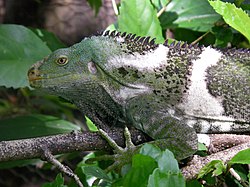Fiji Crested Iguana
| Fiji crested iguana | |
|---|---|
 |
|
| A Fiji crested iguana in the Melbourne Zoo | |
| Scientific classification | |
| Kingdom: | Animalia |
| Phylum: | Chordata |
| Class: | Sauropsida |
| Order: | Squamata |
| Suborder: | Iguania |
| Family: | Iguanidae |
| Genus: | Brachylophus |
| Species: | B. vitiensis |
| Binomial name | |
|
Brachylophus vitiensis Gibbons, 1981 |
|
 |
|
The Fiji crested iguana or Fijian crested iguana (Brachylophus vitiensis) is a critically endangered species of iguana native to some of the northwestern islands of the Fijiian archipelago, where it is found in dry forest.
The generic name, Brachylophus, is derived from two Greek words: brachys (βραχῦς) meaning "short" and lophos (λοφος) meaning "crest" or "plume", denoting the short spiny crests along the back of this species. The specific name, vitiensis, is a Latin adjective derived from the Latin word for Fiji.
The species is closely related to the Fiji banded iguana and B. bulabula. The genus Brachylophus has been suggested to be the descendants of a more widespread lineage of (now extinct) Old World iguanids that diverged from their New World relatives in the Paleogene. Alternatively, the ancestors of these iguanas may have rafted 9000 km west across the Pacific Ocean from the Americas, where their closest relatives are found.
The discovery of Brachylophus vitiensis began when Dr. John Gibbons of the University of the South Pacific was invited to the screening of the movie The Blue Lagoon. The director filmed part of the movie on a remote island and included shots of the native wildlife to enhance the feel of the movie, including a large colorful iguanid. Gibbons, who had been studying the Fiji banded iguana at the time, travelled to the island and identified it as a distinct species.
B. vitiensis is found on the islands of Fiji, in the South Pacific. The species is restricted to tropical dry forests, specifically to the rain shadow forests located on certain islands in Fiji. These forests are one of the most threatened vegetation types in the Pacific. A small population of the Fiji Crested Iguana – less than 80 individuals – can be found on the small island of Macuata. The majority of this species – less than 4000 individuals – is most commonly found on the island of Yadua Taba. The island is a National Trust of Fiji reserve, and is thus the only legally protected population of the Fiji Crested Iguana. The island is now also free of forest burning and the presence of goats, which was a major factor in the initial decline of the species. There are six other Fijian islands where evidence of the species has been recorded: Deviulau, Waya, Mouriki, Monu, Qalito, and Malolo Levu. The population on Malolo Levu seems to be an intermediate of Brachylophus vitiensis and Brachylophus bulabula likely resulting from hybridism in the past. Brachylophus bulabula has been found on neighbouring Mana Island and nearby Viwa Island and there likely was some degree of overlapping of the two species in this area. There also have been hybrids of the two species produced in captivity. The species could have inhabited land that was 500 meters above sea level in the past, but is currently found at 100 meters or less above sea level.
...
Wikipedia

